
 |
|||
|
NIOSH Publication No. 2004-156:Preventing Falls of Workers through Skylights and |
August 2004 |
|
| This Alert describes five deaths resulting from falls through skylights and roof and floor openings. Recommendations are provided to help prevent similar deaths in the future. Contents
| |||||||||||||||||||||||||||
| Background | |
| Recommendations | |
| Acknowledgments | |
| References | |
| Worker/Employer Summary | |
|
|
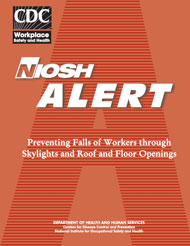
|
2004-156.pdf (Full Document) |
| Related Resources/Publications: NIOSH Alert - Preventing
Worker Deaths and Injuries from Fall Through Skylights and Roof
Openings |
WARNING!
|
The National Institute for Occupational Safety and Health (NIOSH) requests assistance in preventing injuries and deaths from falls of workers through skylights and roof and floor openings. Recent NIOSH investigations suggest that employers, workers, building owners, skylight designers, and skylight manufacturers may not fully recognize or appreciate the serious fall hazards associated with working near skylights and roof and floor openings. As a result, skylights and roof and floor openings may be left unguarded or uncovered, and workers may be assigned to work around these openings without appropriate fall prevention measures in place.
This Alert describes five deaths resulting from falls through skylights and roof and floor openings. Recommendations are provided to help prevent similar deaths in the future.
The recommendations in this Alert should be followed by (1) all building owners and (2) all employers and workers at worksites that may expose workers to unguarded skylights and roof and floor openings. In addition, skylight designers and manufacturers should contribute to worker safety through improved design and labeling of skylights. NIOSH requests that safety and health professionals, government officials, industry associations, unions, and editors of trade journals bring the recommendations in this Alert to the attention of employers and workers.
Occupational fatalities caused by falls remain a serious public health problem throughout the United States. Data collected by the Bureau of Labor Statistics (BLS) Census of Fatal Occupational Injuries indicate that falls are one of the leading causes of traumatic injury death in the workplace, accounting for 13.7% of such deaths (808 of 5,900) in 2001. During that year, 23 workers died in falls through skylights, 11 died in falls through existing roof openings, and 24 died in falls through existing floor openings. Most of these deaths occurred in the construction industry [BLS 2002a].
Data from the BLS Survey of Occupational Injuries and Illnesses show that during 1999, nearly 300,000 workers in private industry sustained injuries involving days away from work as a result of falls. In 1999, an estimated 80 workers were injured in falls through skylights, 100 in falls through existing roof openings, and 617 in falls through existing floor openings. Most injuries occurred in construction, though many injuries occurred in other industries such as manufacturing, retail trade, and services [BLS 2002b].
During the 1980s, NIOSH attempted to prevent work-related falls by targeting falls from elevation for in-depth investigation through its Fatality Assessment and Control Evaluation (FACE) program. The goal of the investigations conducted under FACE is to identify factors that contribute to work-related fatalities and provide recommendations for preventing such events in the future. In 1989, NIOSH published an Alert entitled Preventing Worker Deaths and Injuries from Falls through Skylights and Roof Openings. The Alert identified unguarded skylights and roof openings as fall hazards and offered strategies for fall prevention [NIOSH 1989a].
The present Alert updates the 1989 publication and emphasizes that workers, including young workers, remain at risk of falling through skylights and roof and floor openings. The focus in the updated Alert is on increasing efforts to identify fall hazards and implement prevention measures for reducing serious injuries and fatal falls.
OSHA has developed standards to prevent workers in general industry and in construction from falling through skylights and roof and floor openings. The OSHA General Industry Standard requires that “every skylight floor opening and hole shall be guarded by a standard skylight screen or a fixed standard railing on all exposed sides” [29 CFR* 1910.23(a)(4)]. OSHA also requires that skylight screens meet the following standards:
Skylight screens shall be of such construction and mounting that they are capable of withstanding a load of at least 200 pounds applied perpendicularly at any one area on the screen. They shall also be of such construction and mounting that under ordinary loads or impacts, they will not deflect downward sufficiently to break the glass below them. The construction shall be of grillwork with openings not more than 4 inches long or of slatwork with openings not more than 2 inches wide with length unrestricted [29 CFR 1910.23(e)(8)].
If a fixed railing is used instead of a screen, OSHA requires the following:
A standard railing shall consist of top rail, intermediate rail, and posts, and shall have a vertical height of 42 inches nominal from upper surface of top rail to floor, platform, runway, or ramp level. The top rail shall be smooth-surfaced throughout the length of the railing. The intermediate rail shall be approximately halfway between the top rail and the floor, platform, runway, or ramp. The end of the rails shall not overhang the terminal posts except where such overhang does not constitute a projection hazard [29 CFR 1910.23(e)(1)]
* Code of Federal Regulations. See CFR in references.
In 1995, OSHA construction industry standards for fall protection were revised and consolidated, and they are currently located in OSHA’s Subpart M–Fall Protection [29 CFR 1926.500-503]. Workers must be protected as follows:
Each employee on walking/working surfaces shall be protected from falling through holes (including skylights) more than 6 feet (1.8 m) above lower levels by PFAS (personal fall arrest system), covers, or guardrail systems erected around such holes [29 CFR 1926.501(b)(4)(i)].
Each of these systems is described in detail in 29 CFR 1926.502. The following paragraphs have been reproduced from the OSHA standards to summarize these systems. The full text in the OSHA standards should be used to ensure that the fall protection system selected meets all fall protection criteria and practice requirements.
Personal fall arrest system [PFAS] means a system used to arrest a worker in a fall from a working level. It consists of an anchorage, connectors, a body belt or body harness, and may include a lanyard, deceleration device, lifeline, or suitable combinations of these. As of January 1, 1998, the use of a body belt for fall arrest is prohibited [29 CFR 1926.500(b)].
Anchorages used for attachment of personal fall arrest equipment shall be independent of any anchorage being used to support or suspend platforms and capable of supporting at least 5,000 pounds (22.2kN) per employee attached, or shall be designed and used as follows: (i) as part of a complete personal fall arrest system which maintains a safety factor of at least two; and (ii) under the supervision of a qualified person [29 CFR 1926.502(d) (15)(i)(ii)].
Covers. Covers located in roadways and vehicular aisles shall be capable of supporting, without failure, at least twice the maximum axle load of the largest vehicle expected to cross over the cover [29 CFR 1926.502(i)(1)].
All other covers shall be capable of supporting, without failure, at least twice the weight of employees, equipment, and materials that may be imposed on the cover at any one time [29 CFR 1926.502(i)(2)].
All covers shall be secured when installed so as to prevent displacement by the wind, equipment, or employees [29 CFR 1926.502(i)(3)].
All covers shall be color coded, or they shall be marked with the word “HOLE” or “COVER” to provide warning of the hazard. Note: this provision does not apply to cast iron manhole covers or steel grates used on streets or roadways [29 CFR 1926.502(i)(4)].
Guardrail system means a barrier erected to prevent employees from falling to lower levels [29 CFR 1926.500(b)].
(Note: See 29 CFR 1926.502(b)(1) through (15) Guardrail systems, which details requirements for the installation and use of guardrails. Selected paragraphs that describe requirements when guardrail systems are used around holes are included below.)
When guardrails are used at holes, they shall be erected on all unprotected sides or edges of the holes [29 CFR 1926.502(b)(11)].
When guardrails are used around holes used for the passage of materials, the holes shall have not more than two sides provided with removable guardrail sections to allow the passage of materials. When the hole is not in use, it shall be closed over with a cover, or a guardrail system shall be provided along all unprotected sides or edges [CFR 1926.502(b)(12)].
When guardrails are used around holes that are used as points of access (such as ladderways), they shall be provided with a gate or be so offset that a person cannot walk directly into a hole [29 CFR 1926.502 (b)(13)].
(Note: This Alert addresses the prevention of falls through skylights and roof and floor openings. Other fall prevention systems may be more protective for other fall hazards.)
The FLSA is the primary law governing the employment of youths under age 18. In addition to setting limits on the types of work that youths under age 16 can perform, FLSA prohibits work for youths under age 18 in occupations declared by the Secretary of Labor to be especially hazardous—Hazardous Orders. Youths under age 16 are prohibited from working in construction and manufacturing under Child Labor Regulation No. 3 [29 CFR 570.33(a) and (f)(4)]. Hazardous Order No. 16 (HO 16), Occupations in Roofing Operations, prohibits workers under age 18 from performing roofing work (including repair work) in nonagricultural industries, but it does not prohibit workers under age 18 from installing skylights [29 CFR 570.67]. Some exemptions exist for student learners and apprentices [DOL 2001]. Though no final action has been taken, the Department of Labor has proposed amending HO16 to expand the ban from all roofing occupations to include all work performed on a roof [64 Fed. Reg. 67130 (1999)]. NIOSH supports this amendment based on documented risks to youths on roofs that are not limited to roofing operations [NIOSH 2000a].
The following cases were investigated by the NIOSH FACE program and NIOSH-supported State-based FACE programs. The cases were selected to represent a variety of falls through skylights and other roof and floor openings. Through 2002, the FACE program investigated 43 fatal falls through skylights and roof and floor openings. Complete FACE reports are available on the NIOSH Web site: www.cdc.gov/niosh/face/faceweb.html.
A 43-year-old male laborer at a coatings manufacturing company died after falling though an unguarded, 3-foot-square skylight lens to a concrete floor 14 feet below (Figure 1). The victim and a coworker were clearing snow from the flat roof of the building. The victim walked on the roof through deep snow that completely covered the skylights in that area of the roof. He apparently failed to see the snow-covered skylight and stepped onto its lens, which broke under his weight. The victim’s coworker, who was walking toward the opposite side of the roof, looked back toward the location of the victim after hearing a noise coming from that area. He saw the broken skylight lens and called for help. The skylight did not have a protective screen, cover, or guarding around it [Wisconsin Department of Health and Family Services 1999].
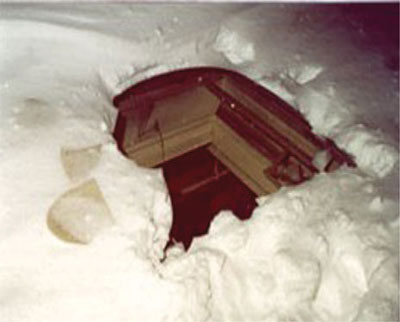 |
Figure 1. Snow-covered 3-foot-square
skylight. |
A 39-year-old, self-employed residential construction contractor died after falling through an unguarded floor opening and onto the concrete footing 10 feet below (Figure 2). He was framing the second floor with two other workers and was in the process of holding a level to the gable end of the second-floor master bedroom when he apparently stepped back into one of two floor openings built to accommodate a chimney. Both the first and second floors had been decked with plywood except for the chimney floor opening. Each floor opening measured approximately 4 feet x 5 feet [Massachusetts Department of Public Health 1999].
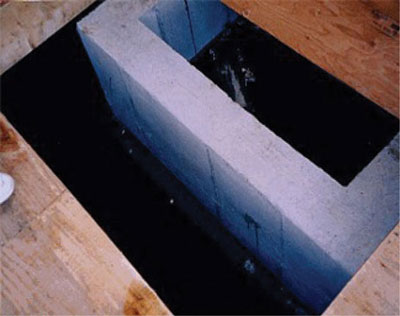 |
Figure 2. Unguarded floor opening. |
A 62-year-old farmer died from injuries sustained when he fell through a corrugated fiberglass panel used on the roof of a pole barn to let light into the building (Figure 3). On the day of the incident, the farmer drove a tractor equipped with a front-end loader next to the barn. He used the loader bucket to climb onto the roof. He walked up the slope of the roof until he reached a rope tied into the roof vent. Evidence suggests that he held the rope in one hand as he pushed snow off the roof. He stepped onto a snow-covered 3- x 10-foot corrugated fiberglass panel that broke, causing him to fall approximately 16 feet to the concrete floor below. The fiberglass panel had not been guarded or marked with a warning to indicate that it covered a hole [Minnesota Department of Health 1994].
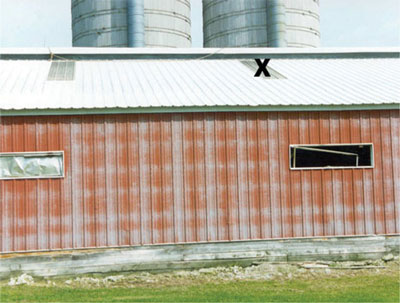 |
Figure 3. Fiberglass panel on metal
roof (marked with an X). |
A 27-year-old carpenter died when he fell through a roof opening to a concrete floor 13 feet below after partially unsecuring a sheet of plywood used to cover the opening. Nails had been removed from one side of a 4- x 8-foot sheet of 5/8-inch plywood that was placed over a 37- x 67-inch roof opening for a heating, ventilating, and air conditioning unit. Evidence suggests that the victim removed nails from one side of the plywood cover so that he could drop an electric cord to the floor below, where power outlets were available. He apparently knelt down and leaned into the opening with the plywood resting on his back to look for someone below who would plug the cord into an electrical outlet. While kneeling, the victim either lost his balance or the weight of the plywood caused him to fall headfirst through the opening [NIOSH 1989b].
A 14-year-old male laborer died from injuries he sustained when he fell through the lens of a 56- x 24-inch, curb-mounted skylight to a concrete floor approximately 12 feet below (Figure 4). Along with several other day laborers, the victim and his 16-year-old brother had been hired by a roofing contractor on the day of the incident to pull up and remove built-up roofing materials from the flat roof of a one-story wholesale florist shop. The victim had been working for approximately 15 minutes pulling up roofing materials by hand when he fell back onto a skylight lens that broke under his weight. The skylight did not have a protective screen, cover, or guarding around it, and the lens was not marked with a warning against sitting or stepping on it. The employer had assigned the victim and his brother to roofing work in violation of HO16 [NIOSH 2002].
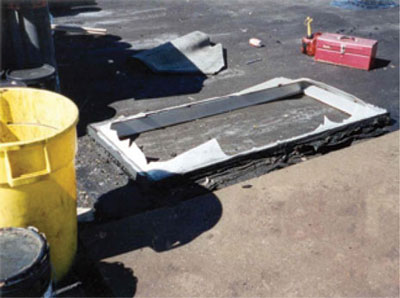 |
Figure 4. Rectangular skylight after
it had been removed from the roof and placed on the ground. |
These incidents suggest that employers, workers, and building owners may not fully appreciate or recognize the seriousness of fall hazards associated with working near unguarded skylights and roof and floor openings. The NIOSH FACE investigations identified the following contributing factors in these fall-through incidents:
Increased efforts by employers, workers, and building owners are needed to address factors that contribute to worker fatalities. NIOSH recommends the following measures to prevent worker injuries and deaths from falls through skylights and roof and floor openings.
Employers should take the following steps to protect workers from falls through skylights and roof and floor openings:
†According to OSHA, a competent person is one who (1) can identify existing and predictable hazards in the surroundings or working conditions that are unsanitary, hazardous, or dangerous to workers, and (2) is authorized to take prompt corrective measures to eliminate them [29 CFR 1926.32].
Additional recommendations for developing and implementing a fall prevention program are available in the NIOSH publication Worker Deaths by Falls [NIOSH 2000b].
Note that employers engaged in some types of residential construction are not required by OSHA to have their fall protection documented in writing. However, they are required to have a plan and to communicate it to all exposed workers [OSHA 1999]. NIOSH recommends that employers’ fall protection plans be written to provide clear safety guidance for supervisors and workers.
Skylight designers and manufacturers should take the following steps to protect workers from falls through skylights:
Building owners should take the following steps to protect workers from falls through skylights and roof and floor openings:
— Post these signs in English and in the predominant language of workers who do not read English. The following example is a warning sign printed in both English and Spanish:
DANGER!
|
¡PELIGRO!
|
— If workers cannot read posted warning signs, warn them verbally. Use an interpreter if necessary.
— Refer to ANSI standards Z535.4 and Z535.2 [ANSI 2002b] and OSHA standards 29 CFR 1910.145 and 1926.200 for guidance on requirements for safety signs and labels.
Workers should take the following steps to protect themselves from falls through skylights and roof and floor openings:
The principal contributor to this Alert was Doloris Higgins of the NIOSH Division of Safety Research. Valuable contributions were made by Virgil Casini and Thomas Bobick, Division of Safety Research. Please direct any comments, questions, or requests for additional information to the following:
Dr. Nancy Stout
Director
Division of Safety Research
National Institute for Occupational Safety and Health
1095 Willowdale Road
Morgantown, WV 26505–2888
Telephone: (304) 285–5894.
For further information about occupational safety and health topics, call 1–800–35–NIOSH (1–800–356–4674), or visit the NIOSH Web site at www.cdc.gov/niosh.

John Howard, M.D.
Director
National Institute for Occupational Safety and Health
Centers for Disease Control and Prevention
ANSI [2002a]. American national standard: product safety signs and labels. New York: American National Standards Institute, Inc. ANSI Z535.4–2002.
ANSI [2002b]. American national standard: environmental and facility safety signs. New York: American National Standards Institute, Inc. ANSI Z535.2–2002.
BLS [2002a]. Table A–9: Fatal occupational injuries by event or exposure and major private industry division, all United States, 2001. Washington, DC: U.S. Department of Labor, Bureau of Labor Statistics [http://www.bls.gov/iif/oshwc/cfoi/cftb0153.pdf].
BLS [2002b]. Occupational injuries and illnesses: counts, rates and characteristics, 1999. Washington, DC: U.S. Department of Labor, Bureau of Labor Statistics, Bulletin 2551.
CFR. Code of Federal regulations. Washington, DC: U.S. Government Printing Office, Office of the Federal Register [http://www.osha.gov].
DOL [2001]. Child labor requirements in nonagricultural occupations under the Fair Labor Standards Act. Washington, DC: U.S. Department of Labor, Employment Standards Administration, Wage and Hour Division, WH–1330, Child Labor Bulletin No. 101.
64 Fed. Reg. 67130 [1999]. U.S. Department of Labor, Wage and Hour Division, Employment Standards Administration: 29 CFR Parts 570 and 579: child labor regulations, orders, and statements of interpretation; child labor violations—civil money penalties; proposed rules.
Massachusetts Department of Public Health [1999]. Self-employed residential contractor dies in ten foot fall through a floor opening on Massachusetts construction site. Boston, MA: Massachusetts Department of Public Health, Massachusetts Fatality Assessment and Control Evaluation Program (MA FACE) Report No. 99MA02201.
Minnesota Department of Health [1994]. Farmer dies after falling through fiberglass skylight panel. Minneapolis, MN: Minnesota Department of Health, Minnesota Fatality Assessment and Control Evaluation Program (MN FACE) Investigation 94MN04001.
NIOSH [1989a]. NIOSH Alert: request for assistance in preventing worker deaths and injuries from falls through skylights and roof openings. Cincinnati OH: U.S. Department of Health and Human Services, Public Heath Service, Centers for Disease Control and Prevention, National Institute for Occupational Safety and Health, DHHS (NIOSH) Publication No. 90–100.
NIOSH [1989b]. Carpenter dies after 13-foot fall through roof opening onto concrete floor. Morgantown, WV: U.S. Department of Health and Human Services, Public Heath Service, Centers for Disease Control and Prevention, National Institute for Occupational Safety and Health, Fatality Assessment and Control Evaluation (FACE) Report No. 89–41.
NIOSH [2000a]. Comments of the National Institute for Occupational Safety and Health on the Department of Labor notice of proposed rulemaking and request for comments on child labor regulations, orders, and statements of interpretation: child labor violations—civil money penalties; 29 CFR Parts 570 and 579. Cincinnati, OH: U.S. Department of Heath and Human Services, Public Health Service, Centers for Disease Control and Prevention, National Institute for Occupational Safety and Health, January 28, 2000.
NIOSH [2000b]. Worker deaths by falls: a summary of surveillance and investigative case reports. Cincinnati OH: U.S. Department of Health and Human Services, Public Heath Service, Centers for Disease Control and Prevention, National Institute for Occupational Safety and Health, DHHS (NIOSH) Publication No. 2000–116.
NIOSH [2002]. Fourteen-year-old laborer dies after falling through a skylight—Alabama. Morgantown, WV: U.S. Department of Health and Human Services, Public Heath Service, Centers for Disease Control and Prevention, National Institute for Occupational Safety and Health, Fatality Assessment and Control Evaluation (FACE) Report No. 2001–07.
OSHA [1999]. STD 3–0.1: a plain language revision of OSHA instruction STD 3.1, interim fall protection compliance guidelines for residential construction. Washington, DC: U.S. Department of Labor, Occupational Safety and Health Administration.
Wisconsin Department of Health and Family Services [1999]. Laborer dies from fall through skylight while shoveling snow on roof. Madison, WI: Wisconsin Department of Health and Family Services, Wisconsin Fatality Assessment and Control Evaluation Program (WI FACE) Report No. 99WI00201.
Mention of any company or product does not constitute endorsement by the National Institute for Occupational Safety and Health (NIOSH). In addition, citations to Web sites external to NIOSH do not constitute NIOSH endorsement of the sponsoring organizations or their programs or products. Furthermore, NIOSH is not responsible for the content of these Web sites.
To receive documents or other information about occupational safety and health topics, contact NIOSH at
NIOSH—Publications Dissemination
4676 Columbia Parkway
Cincinnati, OH 45226–1998
Telephone: 1–800–35–NIOSH
(1–800–356–4674)
Fax: 513–533–8573
E-mail: pubstaft@cdc.gov
or visit the NIOSH Web site at www.cdc.gov/niosh
DHHS (NIOSH) Publication Number 2004–156
August 2004

WARNING!
|
WORKERS should take the following steps to protect themselves from falls through skylights and roof and floor openings:
EMPLOYERS should take the following measures to help prevent worker injuries and fatalities from falls through skylights and roof and floor openings:
*According to OSHA, a competent person is one who (1) can identify existing and predictable hazards in the surroundings or working conditions that are unsanitary, hazardous, or dangerous to workers, and (2) is authorized to take prompt corrective measures to eliminate them [29 CFR 1926.32].
For additional information, see NIOSH Alert: Preventing
Falls of Workers through Skylights and Roof and Floor Openings
[DHHS (NIOSH) Publication No. 2004–156]. Single copies of
the Alert are available free from the following:
NIOSH—Publications Dissemination
4676 Columbia Parkway
Cincinnati, OH 45226–1998
Telephone: 1–800–35–NIOSH
(1–800–356–4676)
Fax: 513–533–8573
E-mail: pubstaft@cdc.gov
or visit the NIOSH Web site at www.cdc.gov/niosh
Department of Health and Human Services
Centers for Disease Control and Prevention
National Institute for Occupational Safety and Health